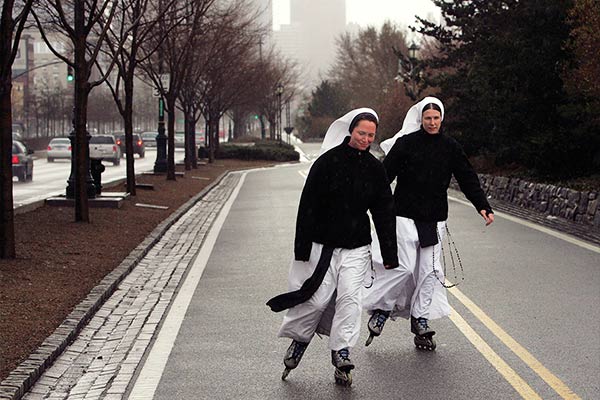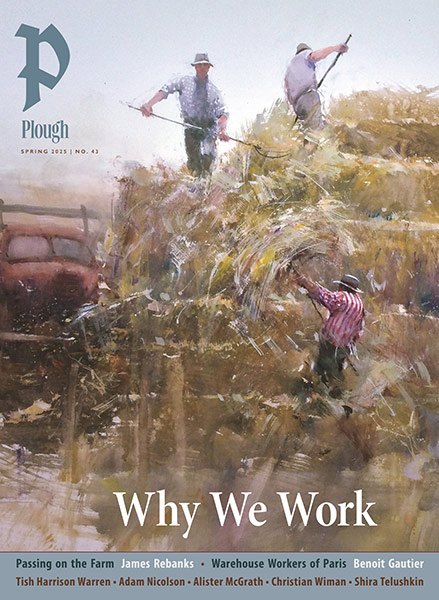Subtotal: $
Checkout-

Traudl Wallbrecher
-

The Man Who Welcomed Immigrants
-

The Soil of Friendship
-

Thomas Müntzer
-

A Time for Courage
-

“What is Truth?”
-

Readers Respond Issue 12
-

At the March For Life
-

Why the Death Penalty Must Die
-

God’s Cop
-

The Teacher Who Never Spoke
-

Bonhoeffer in China
-

The Comandante and the King
-

Confronted by Dorothy
-

Insights on Courage
-

The Art of Courage
-

Why We Hope
-

Harlem Postcards
-

T. S. Eliot’s “Little Gidding”
-

The Need of Refugees
-

Listening to Silence
-

Editors’ Picks Issue 12

The Happy Nuns
Learning Joy through Self-Denial from the Sisters of Life
By Rebekah Domer
March 29, 2017
Next Article:
Explore Other Articles:
What would cause any woman to trade a successful career for a vowed life of poverty, chastity, and obedience? Sister Veronica Mary of the Sisters of Life, a Catholic religious order, puts it this way: “The Christian life is based on love to others, not love to oneself. We have become a world of individuals, a world of people who decide for themselves what is best for me rather than what is best for others. Community life is a declaration that love overcomes the problems that separate people.”
Founded in 1991 by John Cardinal O’Connor, the Sisters of Life is an order that is both active and contemplative: they pray but are not cloistered. Their mission is to assist pregnant women in crisis, offering alternatives to abortion. The order has experienced remarkable growth. Just in 2016, fifteen young women from across North America – all younger than thirty-five and all with at least four-year degrees, including four with doctorates – became postulants. From its small beginning in the Bronx, the order now has eleven locations in the United States and Canada.
Coming from a Christian community myself – I am a member of the Bruderhof – I wanted to learn more about this vibrant fellowship of women, and asked the Sisters for an interview. And so on a frosty November morning, Sister Veronica welcomed me into the Sisters of Life convent in Yonkers, New York. Soon she was telling me her story.

Even nuns get a break on Sunday: Sister Mary Elizabeth and Sister Immaculata in lower Manhattan. Photograph by Tyler Hicks / The New York Times
Eileen Sullivan (Sister Veronica’s birth name) was the third of six children born to devout Catholic parents in Waterbury, Connecticut. She came of age as America rolled through the sixties. Although her parents had taught her to consider God in all she did, when she started nursing school she began to drift away from her faith. Military recruiters talked her into enlisting. “It wasn’t so much the military that I loved but people on a mission together – people with a purpose,” she told me. She signed on for three years and was assigned to a nursing job at Andrews Air Force Base in 1985.
After falling in love with a physician, Eileen left the military to join him in Seattle. He eventually proposed. But the fact that he was not a believer forced Eileen to consider her own convictions: “I realized that I had to give my faith precedence. I knew I could never commit my life to someone who did not share the most vital part of me.” She broke off the relationship.
Returning home to Connecticut, she worked as a cardiac intensive care nurse for five years. On the job she was confronted with many of the ethical dilemmas associated with modern medicine: “I’ll never forget the day I picked up a chart on which a resident had written, ‘Please stop food and fluids on this patient.’ I thought to myself, ‘I can’t do that.’” She began to ask herself, “Am I doing what is morally right in my professional life?” Ever since she had made the decision to put her faith above human love, a restlessness had been growing in her – a hidden sense that there was something more to life than a career, marriage, and material comfort.
On a January day in 1993, Eileen wandered into a church as a priest was delivering a homily that would change her life. The priest spoke about the millions of unborn children being aborted in our country and challenged the congregation to action. Eileen recalled: “Something happened to me at that moment; I walked out of that church thinking, ‘I’m going to be doing this for the rest of my life.’”
Searching for a way to respond to the priest’s challenge, Eileen came across a pro-life prayer group that, in turn, gave her the phone number for a local crisis pregnancy center. But she didn’t call. “Something in me said, ‘If I make this phone call, my life is going to change.’ I didn’t really want that.” She had friends and a family that loved her, an interesting job, and a four-bedroom house with walk-in closets full of clothes. “I knew God was calling me, but I wasn’t ready.”
Still working at the hospital, Eileen read spiritual literature, attended daily Mass, and participated in Bible study groups. At night she went to the chapel. “I remember those nights – just sitting there and feeling such profound peace and yet crying. I asked God, ‘What are you doing in my life? Why are you putting these desires in my heart? I don’t want to be a nun!’”
She continued to date, but even promising relationships led nowhere. “Nothing seemed to be working out. I longed for love – for a singular love. I began to wonder if there was something wrong with me. I prayed, ‘Lord, show me what you want me to do with my love.’”
Finally, Eileen called the local crisis pregnancy center and began volunteering. The work soon became her passion.
She was not alone in this. Circumstances had converged in the early 1970s to encourage many men and women to band together to form the pro-life movement in America. Roe vs. Wade, the landmark Supreme Court ruling of 1973, held that abortion fell within a woman’s “right to privacy,” and accordingly struck down the law restricting abortion nationwide. This controversial ruling coincided with the advent of ultrasound as a routine tool in prenatal medicine, a technology that revealed the indisputable humanity of the unborn child.
Against this backdrop, the Catholic prelate John O’Connor had emerged with a radical message defending the sanctity of the unborn. On a visit to the Dachau Concentration Camp in 1975, O’Connor had vowed to use his remaining time and strength to uphold the sacredness of human life. Several years later, O’Connor, now a cardinal and archbishop of New York, had put out a call in his weekly newspaper column for women who would embrace a charism of prayer and fasting for the cause of life. Thus it was that the summer of 1991 saw the formation of a new order, the Sisters of Life.
In 1995, Eileen joined her pro-life colleagues for a retreat in the Bronx that, unbeknownst to her, was sponsored by the fledgling order. As she recalled: “Entering the room, I was met by the young postulants. They had divested themselves of their professional clothes and were wearing an outfit where you all look alike, just the opposite of the world where ‘I gotta be me, I gotta have my own signature and mark on the world.’” She met one nun who was a former IBM computer engineer; another had worked in robotics for NASA. “I said to myself, ‘Wow! These women are happy – and it seems genuine.’”

Sister Jordan Rose (left) paints faces at the Sisters of Life block party, June 2016. Photograph by Chris Sheridan / Catholic New York
It was their joy that drew Eileen to the Sisters. Still, the following four years were tumultuous. “I had to do the great leap of faith from ‘A Sister – me? Not even an inkling of a chance,’ to ‘Wow! Could this be an option?’ to ‘I need to really think and pray about this,’ to ‘Wow! I think He’s inviting me . . .’”
In September 1999 Eileen took the plunge. She drove with her parents from her home in Connecticut to the St. Frances de Chantal Convent in the Bronx to embark on her postulancy with the order.
“The initial break with my family and friends was extremely difficult,” she told me. “It broke my heart to see my mother weeping; we had always been so close. My entire family attended my clothing ceremony that day, and they were all experiencing such grief.” Although stricken to be causing her family pain, Eileen had no doubts as she put on the postulant’s outfit for the first time. “I was reminded of the scripture that entreats us to ‘put on the new self, created after the likeness of God in true righteousness and holiness’ (Ephesians 4:24). That day as my family drove away, I felt such joy: ‘God, now I can give my heart totally to you!’”
Eileen believed that through her vows of total surrender to God and his service, she was declaring Christ’s victory over the materialistic forces of separation and death that threaten to destroy our world. Her new life was confirmed when she took a new name, Sister Veronica Mary of the Divine Mercy, or, more colloquially, Sister Veronica.Although she now wore a habit, Sister Veronica’s spiritual transformation was not finished. “I had to unlearn so many things. Moving from a human perspective to one focused on God took time and patience.” But as she struggled to surrender herself entirely, Sister Veronica experienced more and more of the peace that had eluded her earlier. “All of a sudden you live, move, and breathe with this deep conviction that you are part of something greater than yourself. Our joy does not depend on extraneous circumstances. Joy is the weapon that can cut through darkness.”
After hearing Eileen’s story, I joined the other Sisters for a common meal. Near me sat Mother Agnes Mary Donovan, the order’s Superior General. I asked her how she would respond if someone criticized the Sisters for throwing their lives and talents away doing menial tasks such as working in the community laundry when they could be achieving prominence in professional life or curing cancer.
“Our community life is meant to be a witness to the life of love God wants people to live,” she replied. “When you look at a community of sisters who are held together by a spiritual bond, it shows people that there is something much deeper to life than what the world offers.”
It struck me that although the Sisters’ calling involves great sacrifice, it is a living imitation of Christ. For Jesus too, doing God’s will required him to lead a nomadic life, going from village to village as the Spirit led, healing the sick, driving out demons, and preaching the good news. He was also led repeatedly into the wilderness for times of prayer and solitude with his Father. Jesus’ life was not his own. From his inconspicuous birth among animals to his death between criminals on a cross, he embodied the sacrificial love of God. He knew he had been sent “to do as the Father has commanded me, so that the world may know that I love the Father” (John 14:31).
What does it mean for the rest of us to do as the Father commands us? As Sister Veronica’s story illustrates, God works uniquely in each life, leading us to varied expressions of his will. But discipleship of Christ always demands a radical turning from a life of sin – that is, repentance and conversion. As Mother Agnes put it, “We leave those aspects of the world behind that inhibit us from pursuing the living God. We do so very purposely so that we are free to pursue the call from the Lord to live in relationship with him. Our separation from the world is to facilitate living in truth with that call. We need a separation from the worldly aspects of the flesh in order to move more deeply in our relationship with the Lord.”
“We need to keep the bar high,” another sister at the table added, “and through that, challenge others to respond with their lives to Jesus’ call to leave father and mother, home and fields for his sake. In a disobedient world and culture, we are called to show people that things are empty and friendships unsatisfactory unless God is in the picture.”
 Sister Veronica Mary (Eileen Sullivan) joined the Sisters of Life in 1999. Photograph courtesy of Sister Veronica Mary
Sister Veronica Mary (Eileen Sullivan) joined the Sisters of Life in 1999. Photograph courtesy of Sister Veronica Mary
Already a subscriber? Sign in
Try 3 months of unlimited access. Start your FREE TRIAL today. Cancel anytime.
What role, I asked the Sisters, do religious communities such as theirs play in the broader Christian church? “Religious life,” one sister answered, “is a foretaste of heaven. Here you have a united people living together in harmony and peace, worshiping the Lord. We remind the church and the world that there is a God, and that he’s worth giving up everything for.”
Sister Veronica added that in her experience, suffering is inherent to a life of discipleship. “If you love God,” she says, “you are willing to suffer for others. This brings us to the key. We live in a world that runs from sacrifice and suffering at all costs. We need to accept the cross in the everyday experiences of life. The richness of life is found in working things out together because it is the love between us that reflects the gospel.”
Some might object that such a way of life together is impractical for all but a few monastics. Yet Scripture makes clear that Christ’s way is opposed to the values of contemporary culture. To the extent that society is built on the individualistic pursuit of material possessions, prestige, and power at the expense of others, it will be unable to comprehend how a life consecrated wholly to God makes sense. Reflecting on Jesus’ words, “What will it profit a man if he gains the whole world and forfeits his soul?” (Matt. 16:26), the English writer J. B. Phillips writes:
The good life is conceived almost entirely in terms of creature comforts, labor-saving appliances, better clothes, better and longer holidays, more money to spend, and more leisure to enjoy.…None of these things is wrong in itself. But when they are assumed to satisfy every desire, ambition, and aspiration of man, we are surely right to be alarmed at the grip of materialism. For when possessions, pleasures, and the thought of physical security fill a man’s horizon, he ceases to ask himself such basic questions as “What am I?” or “What am I here for?”
It is not that we moderns, in our addiction to materialism, have asked for too much – rather, it is that we have been satisfied with too little.
It was this dissatisfaction to which Eileen responded by becoming Sister Veronica. For her, this meant embracing a way of life that is fully human. Reflecting on her first encounter with the Sisters, Eileen recalled, “These women were young; they wanted to change the world, and they were doing it through joy!”
How is it with us who claim to be followers of Christ? Are we standing out as the “light on a hill” that Jesus speaks of in the Sermon on the Mount? Are we the “yeast” that permeates the dough with kingdom values? Do we uphold the uncompromising way of Christ that leads to eternal life for those who are willing to sell all they possess to acquire the pearl of great price?
To be sure, not everyone is called to be a priest, monk, or nun, or (for that matter) to be a member of the Bruderhof. But it’s equally true that none of us who claim to be followers of Jesus is let off the hook. Christ calls each of us to follow him completely, and it is he, not we, who determines where and how we are to serve. If we accept his call wholeheartedly, the joy that shines out from the faces of the Sisters of Life will be ours as well.
Learn more about the Sisters of Life and read their stories at sistersoflife.org.

Did you know that Plough is published by the Bruderhof, a living community of people seeking to follow Jesus together?
Already a subscriber? Sign in
Try 3 months of unlimited access. Start your FREE TRIAL today. Cancel anytime.

































Erna Albertz, Plough.com
Thank you for reading. Domer writes, “It is not that we moderns, in our addiction to materialism, have asked for too much – rather, it is that we have been satisfied with too little.” Do you agree? Please share your thoughts.